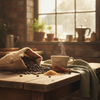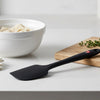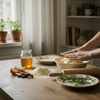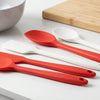Lemon Zester Tool Guide: Easy Steps to Zest Like a Chef
Ever wondered what separates a home cook from someone who really knows their way around the kitchen? It's often the little things—like knowing that the secret to restaurant-quality dishes isn't always fancy ingredients, but the right technique and tools. And when it comes to extracting maximum flavor from citrus, a proper lemon zester tool is your golden ticket to culinary excellence.
Key Takeaways
- A lemon zester tool is designed to remove the aromatic outer peel of citrus fruits without including the bitter white pith.
- Using the right kitchen tools can elevate your cooking from basic to professional quality.
- Extracting zest with a lemon zester adds maximum flavor to your dishes.
- Small techniques and tools often distinguish experienced cooks from home chefs.
Table of Contents
- What Is a Lemon Zester Tool?
- The Role of Zest in Cooking, Baking, and Beverages
- Types of Lemon Zesters & Kitchen Alternatives
- How to Choose the Right Lemon Zester for Your Kitchen
- How to Zest a Lemon Without a Zester
- Maintenance and Care: Keeping Your Zester Sharp
- Storage and Blade Protection
- Troubleshooting Common Zesting Issues
- Beyond Lemons: Zesting Versatility
- Conclusion: Elevate Your Zesting Game
Whether you're adding a bright pop to your weekend pancakes, crafting the perfect cocktail garnish, or following that intimidating soufflé recipe you've been eyeing, zesting transforms ordinary dishes into something memorable. The difference between amateur and professional results? It's all in the zest—literally.
Why Zest Matters: Citrus zest contains concentrated essential oils that pack up to 10 times more flavor than the juice alone. These oils are what give your dishes that bright, aromatic quality that makes people ask, "What's your secret?"
What Is a Lemon Zester Tool?
A lemon zester tool is a specialized kitchen implement designed with one crucial mission: to extract the flavorful outer layer of citrus fruits while leaving behind the bitter white pith. Think of it as precision engineering for your palate—these tools feature sharp, strategically-sized holes or blades that shave off paper-thin ribbons of aromatic zest.
The magic happens in the details. Unlike a regular grater or knife, a proper zester creates the ideal texture and size for maximum flavor release without the harsh bitterness that comes from accidentally including pith in your prep.
Key Fact: Professional chefs consider zesting one of the five fundamental knife skills, alongside chopping, dicing, julienning, and brunoise.
The Role of Zest in Cooking, Baking, and Beverages

Here's where things get exciting. Zest isn't just a garnish—it's a flavor powerhouse that transforms everything it touches. In baking, lemon zest brightens heavy batters and adds complexity to sweet treats. For savory cooking, it cuts through rich sauces and adds freshness to roasted meats. And in cocktails? It's the difference between a good drink and one that makes your guests ask for the recipe.
Pro Tip: Always zest before juicing. Once you've squeezed that lemon, getting clean zest becomes nearly impossible. Plan your prep sequence like a chef—zest first, juice second.
The science behind zest's power lies in those essential oils we mentioned. When you zest properly, you're releasing limonene and other aromatic compounds that are too delicate for heat processing but perfect for finishing dishes or infusing into batters and marinades.
Zest vs. Pith: Understanding the Difference
This is where many home cooks go wrong, and honestly, we get it. When you're excited about that new recipe, it's easy to get aggressive with your zesting. But here's the thing: zest is golden, pith is trouble.
- Zest: The thin, colorful outer layer packed with flavorful oils
- Pith: The white, spongy layer underneath that's bitter and unpleasant
- The Goal: Maximum zest, zero pith
A quality lemon zester tool makes this distinction automatic. The right tool, used with proper technique, gives you consistent results every time—no bitter surprises, just pure citrus perfection.
Types of Lemon Zesters & Kitchen Alternatives
Not all zesters are created equal, and choosing the right one can make the difference between frustrating kitchen prep and effortless citrus mastery. Let's break down your options so you can find the perfect match for your cooking style.
At a Glance: Zester Types
- Classic Zester: Traditional tool with small holes for quick, fine zest
- Microplane Zester: Rasp-style design for ultra-fluffy zest
- Box Grater: Multi-purpose option with zesting capabilities
- 2-in-1 Tools: Combines zesting with channel knife functionality
Classic Lemon Zester - The Original Game-Changer
The classic zester features a row of small, sharp-edged holes along a steel head attached to a comfortable handle. This lemon zester tool creates fine, thread-like strips of zest that work beautifully in baking and cooking applications.
- Produces consistent, fine zest strips
- Compact and easy to store
- Affordable entry point for home cooks
- Excellent control over zest size
Best For: Bakers who need precise, fine zest for batters and icings, or anyone wanting a reliable, no-frills zesting experience.
Microplane Zester - The Professional's Choice
Originally adapted from woodworking tools, the microplane zester revolutionized citrus prep. Its long, narrow design features hundreds of ultra-sharp, etched blades that create incredibly fine, fluffy zest with minimal effort.
Pros
- Effortless zesting with light pressure
- Creates the finest, most aromatic zest
- Works on hard cheeses and spices too
- Professional-grade results
Cons
- Higher price point
- Requires protective cover for storage
- Blades can be delicate
Box Grater with Zesting Side - The Multi-Tasker
Many box graters include a fine zesting side alongside their standard grating surfaces. While not as specialized as dedicated zesters, they offer versatility for kitchens with limited storage space.
Pro Tip: When using a box grater for zesting, work over a clean cutting board and use gentle, downward strokes. The larger surface area can make it easier to accidentally include pith.
2-in-1 Zester & Channel Knife - The Bartender's Best Friend
These tools combine traditional zesting capabilities with a channel knife feature for creating decorative citrus twists. Perfect for cocktail enthusiasts and anyone who loves impressive garnishes.
- Dual functionality saves drawer space
- Creates both zest and decorative peels
- Ideal for entertaining and mixology
- Often features ergonomic handles
How to Choose the Right Lemon Zester for Your Kitchen

Selecting the best zester tool depends on your cooking habits, storage space, and budget. Here's what matters most when making your decision.
Blade Material and Sharpness
The blade is everything in a zester. Look for high-quality stainless steel that maintains its edge over time. Cheap zesters with dull blades will tear rather than cleanly cut the zest, leading to bitter pith contamination and frustrating prep work.
Key Fact: Premium zesters use photo-etched blades, which stay sharper longer than stamped alternatives and create more consistent results.
Handle Comfort & Design
You'll be applying pressure and making repetitive motions, so ergonomics matter. Look for handles with:
- Non-slip grips for wet hands
- Comfortable length and weight balance
- Durable materials that won't crack or break
- Easy-to-clean surfaces
Size Matters: A handle that's too short forces you to work close to sharp blades, while one that's too long becomes unwieldy. The sweet spot is typically 6-8 inches total length.
Ease of Cleaning
Citrus oils and small zest particles love to cling to zester blades. The easier your tool is to clean, the more likely you'll reach for it regularly. Consider these factors:
- Dishwasher-safe construction
- Smooth surfaces without hard-to-reach crevices
- Blade design that releases stuck zest easily
- Materials that resist staining and odor absorption
How to Zest a Lemon Without a Zester
Don't have a dedicated zester? No problem. While we always recommend the right tool for the job, these kitchen hacks can save the day when you're in a pinch. For more creative kitchen solutions, check out our new approach to garlic for inspiration.
Quick Answer: Use the finest side of a box grater or carefully peel with a vegetable peeler, then mince the peel with a sharp knife, avoiding the white pith.
The Vegetable Peeler Method
A sharp vegetable peeler can create thin strips of zest that you can then mince with a knife. The key is using light pressure and working in small sections to avoid the pith.
- Wash and dry your lemon thoroughly
- Hold the peeler at a shallow angle against the lemon
- Make light, short strokes to remove only the colored portion
- Stack the peeled strips and mince finely with a sharp knife
Fine Grater Technique
The finest side of your box grater can work in a pinch, though it requires more careful technique than a dedicated lemon zester tool. For a detailed visual guide, see how to zest a lemon from The Pioneer Woman.
Watch Out: Box graters can be aggressive. Use light pressure and check frequently to avoid grating into the bitter pith layer.
These methods work, but they require more attention and skill than using the proper tool. If you find yourself zesting regularly, investing in a quality zester will save time and deliver better results every time.
Maintenance and Care: Keeping Your Zester Sharp

A well-maintained lemon zester tool can last for years, delivering consistent results every time you reach for it. The key is establishing good cleaning habits and proper storage techniques that protect those precision blades.
Pro Tip: Rinse your zester immediately after use. Dried citrus oils and zest particles become much harder to remove once they've had time to set.
Immediate Cleaning Steps
Right after zesting, follow these quick steps to keep your tool in peak condition:
- Rinse under warm running water to remove loose zest particles
- Use a soft brush or toothbrush to gently scrub the blade surface
- Work from the back of the blade toward the cutting edge to avoid dulling
- Dry thoroughly with a clean towel to prevent water spots
Key Fact: Most quality zesters are dishwasher safe, but hand washing extends blade life and maintains optimal sharpness longer.
Dealing with Stubborn Buildup
When citrus oils create sticky residue or zest gets lodged in the blade holes, try these techniques:
- Soak in warm, soapy water for 10-15 minutes
- Use a toothpick to gently dislodge stuck particles from holes
- For microplane zester models, brush along the blade direction
- Rinse with hot water to dissolve stubborn oils
Avoid These Mistakes: Never use steel wool or abrasive cleaners on zester blades. These can damage the precision edges and reduce effectiveness.
Storage and Blade Protection
Proper storage protects both your zester and your fingers. Sharp blades need protection from damage and dulling caused by contact with other utensils.
Safe Storage Options
- Protective covers: Many zesters come with blade guards or covers
- Magnetic strips: Keep zesters visible and easily accessible
- Drawer organizers: Separate compartments prevent blade contact
- Hanging hooks: Utilize vertical space while protecting blades
Best Practice: If your zester didn't come with a protective cover, consider purchasing one separately or wrapping the blade in a kitchen towel before storing.
Troubleshooting Common Zesting Issues
Even with the best zester tool, technique matters. Here's how to solve the most common problems home cooks encounter:
Problem: Getting Too Much Pith
Solutions
- Use lighter pressure and shorter strokes
- Work in small sections around the fruit
- Keep the zester at a shallow angle
- Stop when you see white pith appearing
Prevention
- Choose firm, fresh citrus with thick peels
- Rotate the fruit frequently while zesting
- Practice on less expensive lemons first
- Consider a microplane for more control
Problem: Uneven Zest Texture
Inconsistent zest usually comes from uneven pressure or a dull blade. If your zester is producing ragged pieces instead of clean, fine strips, it might be time for a replacement or a technique adjustment.
Quick Fix: Maintain consistent, light pressure and let the blade do the work. If the problem persists, your zester may need replacement.
Beyond Lemons: Zesting Versatility
Your lemon zester tool isn't limited to just lemons. Expand your culinary horizons with these creative applications:
Other Citrus Fruits
- Limes: Perfect for Mexican and Thai dishes
- Oranges: Excellent in baking and marinades
- Grapefruits: Adds brightness to salads and cocktails
- Meyer lemons: Sweeter, more delicate flavor profile
Surprising Zester Uses
Professional chefs know that zesters excel at more than just citrus:
- Fresh ginger: Creates fine threads without the fibrous texture
- Hard cheeses: Parmesan, aged cheddar, and Pecorino Romano
- Chocolate: Fine shavings for dessert garnishes
- Nutmeg: Freshly grated spice beats pre-ground every time
- Garlic: Ultra-fine pieces that distribute evenly
Chef's Secret: A microplane zester creates the finest possible garlic texture, perfect for vinaigrettes and delicate sauces where you want flavor without visible pieces.
Conclusion: Elevate Your Zesting Game
The right lemon zester tool transforms citrus prep from a chore into a pleasure. Whether you choose a classic zester for straightforward zesting, a microplane zester for professional results, or master the art of how to zest a lemon without a zester using kitchen alternatives, the key is understanding your options and choosing tools that match your cooking style.
Remember that quality matters more than quantity when it comes to kitchen tools. A single, well-made zester will serve you better than a drawer full of mediocre alternatives. Invest in sharp blades, comfortable handles, and easy-to-clean designs that encourage regular use.
Final Thought: Great cooking starts with great ingredients, but the right tools help you unlock their full potential. A quality zester doesn't just extract citrus oils—it captures the essence of what makes home cooking special.
With proper technique, regular maintenance, and a willingness to experiment beyond basic lemon zesting, you'll discover that this simple tool opens up a world of flavor possibilities. From brightening winter stews to creating show-stopping dessert garnishes, your zester is ready to help you cook with confidence and creativity. For a delicious way to use your zest, try this lemon dill yogurt sauce recipe.
Frequently Asked Questions
What is the best tool for zesting lemons?
The best tool for zesting lemons is a dedicated lemon zester or microplane. These tools are designed with fine, sharp holes that gently remove the flavorful outer peel without digging into the bitter white pith underneath. A quality lemon zester makes zesting effortless, precise, and mess-free—perfect for adding that bright, citrusy kick to your dishes.
What is the difference between a lemon zester and a grater?
A lemon zester is specifically designed to remove thin strips of citrus peel, focusing on just the flavorful outer layer without the bitter pith. A grater, on the other hand, typically has larger holes meant for shredding cheeses or vegetables, which can result in uneven zest and more pith. Essentially, a zester offers precision and finesse, while a grater is a more general tool that may not deliver the same clean zest.
How do you use a lemon zester?
To use a lemon zester, simply hold the lemon firmly in one hand and the zester in the other. Lightly drag the zester across the lemon’s surface, applying gentle pressure to remove just the thin, colorful outer peel. Rotate the lemon as you go to zest evenly, avoiding the bitter white pith underneath. The fine strips you collect are perfect for brightening up desserts, salads, and sauces.
Can you use a cheese grater as a lemon zester?
Yes, you can use a cheese grater as a lemon zester in a pinch, but it’s not ideal. Cheese graters often have larger holes that can remove chunks of the lemon peel along with the bitter pith, which affects the flavor. For the best, clean zest and to avoid bitterness, a dedicated lemon zester or microplane is your go-to tool.
Do you wash lemons before zesting?
Absolutely! Always wash lemons thoroughly before zesting to remove any dirt, wax, or pesticides from the peel. Since the zest is the outermost layer and directly contacts your food, cleaning the lemon ensures your zest is fresh, safe, and free from unwanted residues.
Do zesters get dull?
Yes, zesters can get dull over time, especially with frequent use or if used on harder surfaces. A dull zester won’t remove zest cleanly and can make the process frustrating. To keep your zester sharp, avoid zesting over hard surfaces like ceramic bowls and consider replacing it when you notice it losing its bite—because a sharp tool means zest done right every time.




